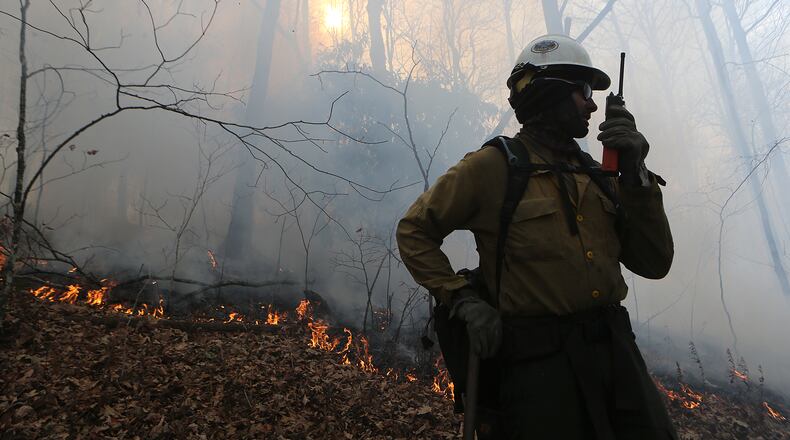Raging wildfires became a global issue in 2020, impacting countries like Australia, Indonesia and Brazil, and again hitting the western United States. They were some of the worst wildfires in decades for some nations, reminding many Georgia firefighters of the 2016 blazes that tore through the northern part of this state and left an indelible mark on them and the area.
Some clearly remember the air, full of thick, black smoke, as the flames made their way across the vast mountain landscape. Sadly, it wasn’t a rare sight.
“In 2016, it was so easy for one little ember to just float across your line and just ignite on the other side,” Darryl Jackson recalled.
Jackson, who has been with the Georgia Forestry Commission for 19 years, vividly remembers having one thing in mind as he battled a blaze on Lookout Mountain four years ago.
“I was just praying for rain,” he said.
The wildfires of 2016, from late September to mid-November, were fueled by North Georgia’s heavy drought that year, as Mother Nature didn’t offer much relief. An accumulation of low relative humidity, a lack of moisture and dead organic matter created enough heat to cause firestorms to rage at an intensity that stunned many firefighters.
“I’ve literally seen (a) live, growing tree burn through at the bottom and fall over because there was no moisture in that tree. That tree was stressed. It was thirsty and it was so dry that the fire just burned right through it,” Jackson said. “It burned it like it was a log in a fireplace, but it was a live tree. That’s how bad things were.”
The fires, which killed more than a dozen people and turned 1.4 million acres into parched kindling in the Southeast, came with a hefty price tag. Georgia spent $3.1 million that year fighting fires in multiple counties, The Atlanta Journal-Constitution previously reported.
According to the GFC’s Area Fire Management Officer, Kris Butler, it was neither an anomaly nor a new normal for Georgians.
“In the 1950s, (we) had a similar wildfire event and then, you know, dating back into the 1920s, there was a pretty good (fire),” he said. “One thing we have to take into account is, in the 1950s versus 2016, we have more urban interface. In other words, we have more homes impacted.”
The GFC estimates that 13 homes valued at more than $630,000 were completely destroyed from October to November that year.
Jackson, Butler and Seth Pierce were just some of the firefighters on the front line, saving homes and lives as intense blazes crossed their paths.
‘Chaotic and stressful’
“It was kind of chaotic and stressful,” Pierce said of his first day as his team planned how to tackle the fires that were progressing through the valley of Tatum Gulf in Dade County in northwest Georgia.
Pierce arrived at the Tatum Gulf fire on the evening of Nov. 11 that year. He was assigned as a fire control operations supervisor at the GFC.
“It really didn’t slow down for several nights after that just because of the fact that we had so many houses that we were having to deal with,” he said. “(We were trying to) stay just ahead of the fire so it didn’t have the opportunity to make a run at the mountain on its own.”
He remembers seeing flames reach up to 20 feet as dry conditions and high wind speeds drove the fires. By the time his team managed to contain that blaze after approximately 17 days, more than 5,000 acres had been burned.
Meanwhile, more than 27,000 acres were burned in Fannin County, and over 13,000 in Rabun County.
In Polk County, the damage was significantly less; only 165 acres were burned. But that fire was just as treacherous. It was one of the areas where Butler was assigned to assist.
On Oct. 2, he said he was full of adrenaline and ready for a challenge when he was dispatched to fires in Polk, Dade and Fannin counties.
“I was bouncing from fire to fire as a manager,” he recalled. “What really impressed me was the volume and the amount of new fire starts that we had. Just with each day brought more and more fire starts.”
According to Butler, firefighters with the GFC go through extensive training before being allowed to fight wildfires anywhere in the U.S. He has personally assisted with fires in multiple states, including Arizona, California and Texas.
Working 16 hours a day with approximately 150 to 170 firefighters, Butler and his colleagues were equipped with an assortment of tools. Along with the help of bulldozers to clear debris, as well as helicopters and air tankers to pour water, firefighters endured arduous labor on the ground.
“It’s very taxing on the body, particularly when you’re doing it for days on end,” Pierce said.
With the use of hand tools, ranging from rakes and shovels to leaf blowers and chainsaws, firefighters cleared trees and shrubs all the way down to mineral soil to prevent the fires from advancing, especially in mountainous terrains.
“They’re down on the side of a mountain, standing at an angle, trying to put in a break. That’s your hardest work right there,” Jackson said. “There are times you can’t put a dozer off the side of a mountain. You can’t run water off the side of a mountain. You’ve just got to get out there and do the grunt work to get it done.”
During the process, Jackson learned a valuable lesson.
“I learned that if we need help, we can get it,” he said. “We didn’t have the people. We needed help. And we had people from, you know, Middle or South Georgia. And if it had continued to get worse, that help could have come from out of state.”
‘Feeling the crunch’
Across Georgia, resources were being strained, leading some agencies in other parts of the state to assist with protecting structures and getting the fires under control.
“We were feeling the crunch. Resources were not available across the nation because the Western crews had pretty well gone off for their season. So, we were very limited in what was available,” Pierce said.
Crews rotated in 24-hour shifts, and Cherokee and Forsyth county firefighters, as well as approximately 30 inmates from five prisons, were deployed in Dade County to clear combustible materials around homes.
At the time, most firefighters were also assisting with evacuations, setting up shelter and educating residents on how to prepare and protect themselves from the threat through a program called Firewise USA, which the agency said it continues to follow.
“That kind of an educational program tells landowners and homeowners how to landscape their property to make it less conducive to fire activity,” Butler said.
The program also provides people with “the proper building techniques,” Jackson added.
Credit: Curtis Compton
Credit: Curtis Compton
Pierce said he believes it takes “a special kind of person to work in this field,” especially one who has a sense of duty toward communities. It was a trait Butler said he was amazed to see from firefighters who were on the ground in 2016.
“I think that high-level commitment to public safety motivates. Knowing that you’re kind of the lifeline, you’re the only measure between someone losing a home or the home being saved, it’s kind of dependent upon you. I think that, that really heightens the level of commitment,” Butler said.
“We all know coming into this that there’s obviously potential to lose your life doing it. And most of us that have some experience with this career have been in a situation where we thought that might be the one,” Pierce said. “But really once that situation is over, and you realize everything’s good, you’re safe, we just dump it in the back of our mind and get back to doing what we need to be doing.”
About the Author
Keep Reading
The Latest
Featured






